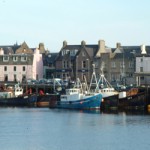Comhairle nan Eilean Siar’s Archaeology Service has recently secured a grant from Historic Scotland equivalent to 70% of the cost of the ambitious Udal project in North Uist. The Comhairle itself has contributed the additional 30% funding for the project to carry out a post-excavation assessment of the material and the records generated through the excavation. As a result of this work, it will be possible for further analysis of the materials to be undertaken in future to bring this incredibly important site to publication.
“Archaeology of the Hebrides”
The Udal is one of the most important archaeological sites in the UK, having been continuously occupied for some 5000 years. Between 1963 and 1995 a major research excavation was undertaken on the site. Excavated by a charismatic and passionate director, Ian Crawford, the Udal was technically ahead of its time, having been one of the first sites to use the modern techniques that archaeologists now take for granted. During the excavations, Mr Crawford discovered a huge and highly significant landscape of domestic occupation, funerary and ritual behaviour dating from around 3000bc to the 20th century. Due to personal reasons Ian Crawford has been unable to complete his life’s work and has made the archaeological archive accessible for the first time since the excavations took place.
Rod McCullagh, Historic Scotland Archaeologist, said: “The site name Udal, in North Uist, already has a place in archaeological literature but most texts refer to its potential; we know it as a place where answers to many key questions might one day emerge.
“With over 3000 years of human settlement and displaying many phases in elaborate well-preserved detail, the Udal deserves a much wider dissemination and will stand comparison with most major monuments in Europe.
“The current project builds on the years of dedicated, innovative work of the excavations’ director, Iain Crawford, and his teams and intends to reinvigorate the process of analysis and reporting.
“The publication of this new work will, we hope, raise the profile of the extraordinary archaeology of the Hebrides and spread its fame far beyond the western seaboard of Scotland.
Work on the current phase of the project began in April 2011 and is due to end in April 2012.
Hebrides Today brings you the latest news from the Western Isles




 Welcome
Welcome Double success for Gaelic radio at media awards
Double success for Gaelic radio at media awards Grant astonished at Allan’s hypocracy over ADS
Grant astonished at Allan’s hypocracy over ADS SHEPD invites island communities to make plans to weather the storms
SHEPD invites island communities to make plans to weather the storms Grant deeply concerned at suspension of Doighead respite service
Grant deeply concerned at suspension of Doighead respite service Scotland’s fishing industry ‘at mercy of a lottery of London priorities’ says MP
Scotland’s fishing industry ‘at mercy of a lottery of London priorities’ says MP Record year for regional airport operator
Record year for regional airport operator Follow the Queen’s example and visit the Isles, says MP
Follow the Queen’s example and visit the Isles, says MP
Leave a Reply